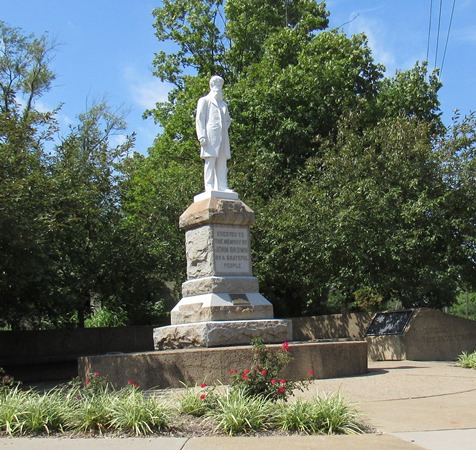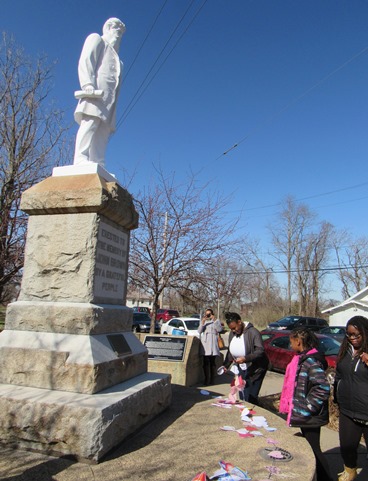

by Mary Rupert
Marvin Robinson III noticed on Nov. 19 that there was damage to the John Brown statue near 27th and Sewell in Kansas City, Kansas.
The statue had been vandalized previously, and was restored in 2018, when a ceremony was held at the site in April 2018.
The vandalism comes during a time when the Quindaro Ruins are being developed into a historic site that may attract visitors who are interested in the history of the Underground Railroad. The area has been named the Quindaro Townsite National Commemorative Site. Quindaro is a pre-Civil War town on the Missouri River in Wyandotte County that was settled by Wyandot Indians, abolitionists and African-Americans.
According to Robinson, he had received calls about concerns at the Quindaro Ruins, Quindaro Cemetery and truck activity, and he asked the callers to contact the Unified Government, mayor’s office or commissioners’ office.
As he stopped to visit the John Brown Memorial on Nov. 19, Robinson saw that the scroll in the statue’s right hand, and part of the right hand, was gone.
It appeared to have been chiseled, according to Robinson.
“It traumatized me, it’s like everybody’s so busy throwing barriers and interceptors in the way of trying to get the archaeological foundations to be a non-priority,” Robinson wrote. He has supported more archaeological work to be done at the Quindaro Ruins.
“I just don’t get it,” Robinson stated about the reason behind the vandalism.
File photos from the Wyandotte Daily showed there was no scroll in the statue’s hand when a photo was taken of the statue on July 27, 2019. There was a scroll in the hand in a photo taken in April 2018 of the restored statue.
The nearby historic Quindaro Cemetery is also a concern for Robinson, who had received phone calls about it.
On Nov. 20, Robinson went to the Quindaro Cemetery and saw heavy equipment vehicles, a crane and bulldozer nearby.
According to Robinson, the road had sunk to almost the height of the Quindaro Creek.
Robinson had received photos from residents showing tombstones that had been tossed about, he stated.
A grave marker for James Milton Turner, a Union Army soldier, had been completely knocked over, he stated. A long unseen World War II veteran’s grave marker is now at the edge of a new road that has been cut through, he added.
He talked with a heavy equipment operator who had contracted with Phillips 66 to do pipeline maintenance, he stated.
“I was just trying to tell the contract worker, that just because it’s a cemetery, the people whose loved ones are buried here, still love their family members,” Robinson stated.
He stated he wants to ask Phillips 66 to meet with family members to address solutions.
The Kansas City, Kansas, Police Department is investigating the possible vandalism to the John Brown statue, and is looking at whether it is new damage or damage from the year before, according to a spokesman.
Story and photos copyright 2019 by Mary Rupert

In reply to Marvin Robinson III, your effort and interest in the Quidaro area and ruins is appreciated. I do not know the “ official” name of the old cemetery but the Quindaro Cemetery is located on the northeast corner of 38th and Parallel. Growing up in the area starting 91 years ago I only knew the name of the cemetery near the ruins as the “Indian Cemetery” even though others (non Indian) were buried there. Perhaps you are correct, as there could possibly be two Quindaro Cemeteries. It is interesting and research is needed.
I may have some information that may answer Mr. Wehmeyer’s comments about Quindaro Cemetery (ies).
The Quindaro Cemetery adjacent to the Brown statue at 27th and Sewell Avenue was the Black cemetery. While the cemetery at 38th and Parallel Parkway was the white cemetery. Similarly, the Methodist Church started the now defunct Western University to serve black students. The church also established the now defunct “Kansas City University” at 3300 Parallel for white students. (It is now the Seventh Day Adventists Conference Center.) The school was never connected to the University of Kansas City in Kansas City, Missouri. There is a historic marker near the entrance at 33rd and Parallel. So, there were two cemeteries and two universities. One of each was for black folks and the other was for white folks. All of this occurred just after the Civil War. Arcadia Publishing’s history book about “Kansas City, Kansas” (available at Varsity Sporting Goods) explains both locations.
Joe Vaughn, “Thanks” for jogging my memory. I do remember the two Quindaro cemeteries and the reason for their existence. For some reason I thought that the Cemetery that Marvin Robinson III was referring to, was the one on top of the bluff near the ruins. When I was growing up the only way to access the Cemetery was a poorly maintained, rut filled entry way, from the Quindaro ruins. It was up the hill in back of what was the old hotel. The Cemetery overlooks the ruins and the Missouri River. Several years ago I gave the Wyandotte Historical Society two black and white photos, showing some of the tomb stones. That is the Cemetery that I referred to knowing as the “Indian” Cemetery.
Further comment about the two cemeteries (Quindaro and Indian): I should note that if anyone interested looks at those photos, now at the Wyandotte Historical Society files, that there are two men in one picture. The man on the left is my father, William F. Wehmeyer; born in Wyandotte County in 1983. The other is my friend from childhood until his death , Gordon Haggard. Viewing to the right in the picture would be the KCK Waterworks and the Fairfax bridge. Looking to the left would be towards Parkville, Missouri. Immediately below the hill and not in view, would be our swimming hole in the river, called the Big Eddy. Not seen but immediately to the right at the bottom of the hill would be the Quindaro ruins.